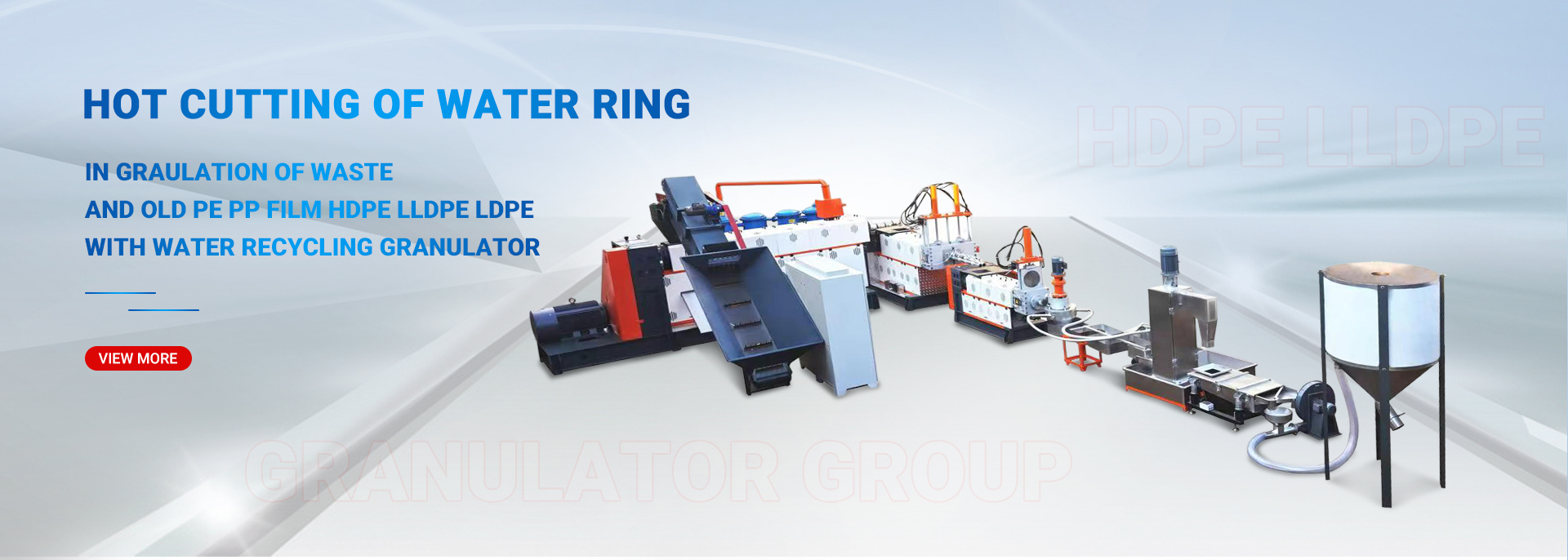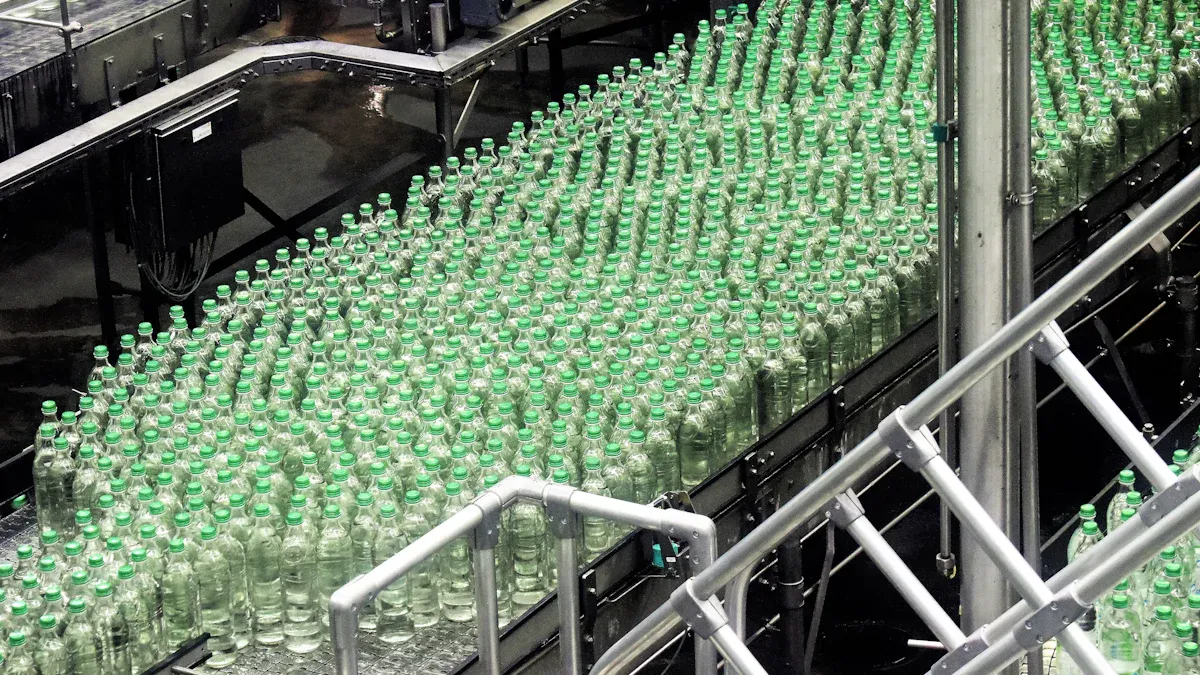
Selecting the right bottle making machine directly impacts production efficiency and cost savings. InterTech reports that companies have cut costs by 25% or more by aligning machine features with specific needs. The following chart highlights key metrics that drive these savings:
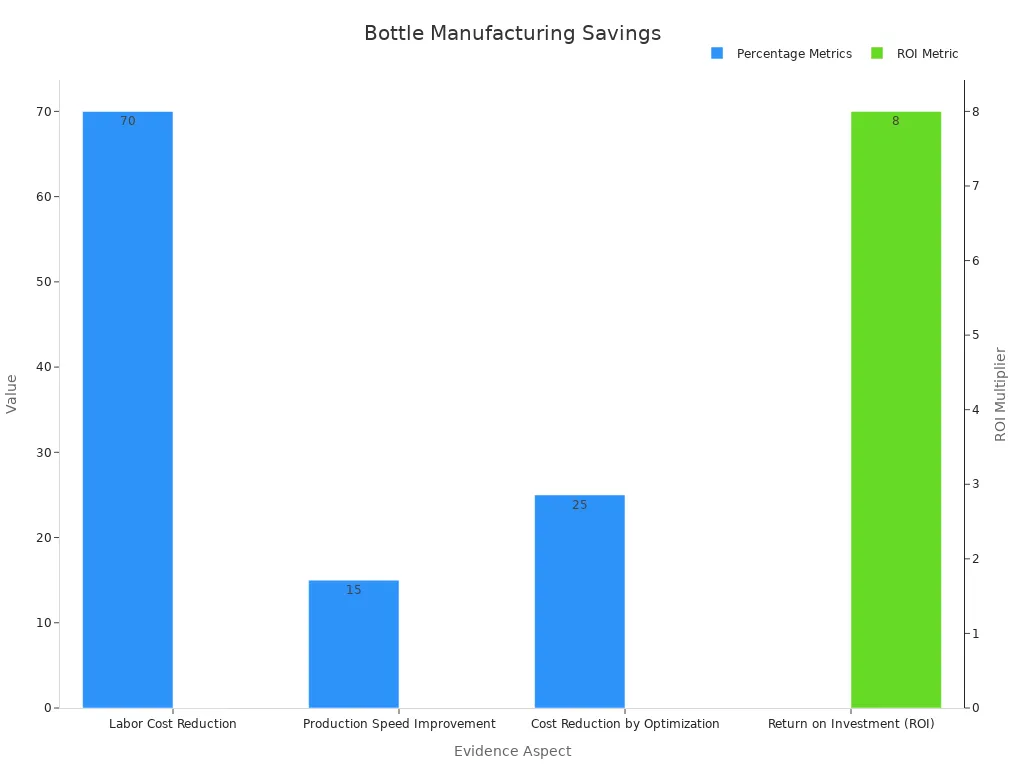
Key Takeaways
- Choose a bottle making machine that matches your production needs by considering bottle types, output speed, and precision to ensure efficiency and quality.
- Invest in automation and energy-efficient features to reduce costs, improve reliability, and support sustainable manufacturing practices.
- Plan your budget carefully by focusing on essential features, avoiding unnecessary add-ons, and preparing for future growth with modular and upgradeable systems.
Assessing Production Needs for Your Bottle Making Machine
Identifying Bottle Types, Sizes, and Shapes
Every production line must begin with a clear understanding of the bottles it will produce. Modern manufacturing serves a wide range of industries, each with unique requirements for bottle types, sizes, and shapes. For example, the cosmetics and personal care sector demands both aesthetic appeal and functional packaging, often requiring machines that handle diverse cap designs and materials. The chemical industry prioritizes robust, leak-proof bottles to ensure safety, while household and industrial sectors need machines that accommodate various shapes and sizes for efficiency and reliability.
| Industry Sector | Bottle Characteristics and Machine Capabilities |
|---|---|
| Cosmetics & Personal Care | High demand for aesthetic and functional packaging; machines handle diverse cap designs |
| Chemical Industry | Requires robust, leak-proof capping for hazardous substances; stringent safety needs |
| Household & Industrial | Need for efficient, reliable capping; machines accommodate various bottle shapes and sizes |
| Beverage | High-speed capping, precision, and airtight seals |
| Pharmaceutical | Precision and airtight seals, strict quality standards |
Statistical studies show that consumer preferences for bottle shapes influence design decisions. Researchers use 3D models and consumer surveys to quantify how different shapes impact perception and usability. Advanced algorithms, such as Interactive Genetic Algorithms, help manufacturers identify preferred designs, ensuring that the final product aligns with market trends and customer expectations. This data-driven approach supports the selection of a bottle making machine that can adapt to a variety of shapes and sizes, maximizing flexibility and market reach.
Calculating Required Output and Throughput
Production targets drive the selection of machinery. High-production environments often require automated lines capable of producing between 60 and 120 bottles per minute. These lines maintain high output rates while handling different product viscosities and ensuring accuracy. The integration of technologies like IoT, AI, and PLC systems further optimizes speed and precision.
Key performance indicators (KPIs) provide a framework for evaluating production needs:
| KPI Metric | Description |
|---|---|
| Production Efficiency Rate | Ratio of actual output to potential output, critical for measuring manufacturing effectiveness. |
| Cost Per Unit Produced | Total cost incurred to produce a single unit, essential for cost management and pricing. |
| Recycling Rate Of Raw Materials | Percentage of raw materials sourced from recycled content, supporting sustainability goals. |
| Waste Reduction Percentage | Measures reduction in waste generated, improving efficiency and lowering disposal costs. |
| Inventory Turnover Ratio | Frequency inventory is sold or used, indicating stock management efficiency. |
| Customer Satisfaction Score | Measures how well products meet customer expectations, impacting market competitiveness. |
| Return On Investment (ROI) | Profitability of investments, guiding financial decisions. |
Monthly reviews of these KPIs help manufacturers adjust production targets and improve operational efficiency. For example, EcoBottle Innovations achieved a consistent production efficiency rate of 90% over several years, demonstrating the value of regular KPI monitoring. Companies that track these metrics can proactively address bottlenecks, reduce waste, and optimize resource allocation.
Tip: Regular KPI reviews can improve production target achievement by up to 30%, supporting proactive decision-making.
Determining Automation and Control Requirements
Automation and control systems play a crucial role in modern bottle production. The global market for automated bottle making machines reached USD 1.2 billion in 2024, with a projected annual growth rate of 5.2%. Manufacturers now integrate advanced technologies to enhance productivity and reduce operational costs.
Key automation features include:
- AI-driven quality control systems for real-time defect detection
- Predictive maintenance algorithms to minimize downtime
- Intelligent process automation for consistent output
- Digital twins and real-time analytics for factory simulation and decision-making
- Energy-efficient furnaces and servo-driven motors for sustainability
- Smart sensors and IoT connectivity for real-time monitoring
Industry 4.0 technologies enable real-time monitoring, predictive maintenance, and data-driven optimization. These advancements improve production speed, reduce human error, and support sustainable manufacturing practices. However, companies must consider the initial capital investment and energy consumption when selecting automation features.
Note: Emerging trends focus on lightweight bottle production and sustainable, energy-efficient technologies, aligning with global sustainability goals.
Matching Bottle Making Machine Capabilities to Business Requirements
Evaluating Output Speed and Precision
Manufacturers must evaluate both output speed and precision when selecting equipment. High-speed production lines deliver more bottles per hour, but precision ensures each bottle meets quality standards. Companies often prioritize machines that maintain consistent wall thickness and accurate dimensions. Advanced control systems help operators monitor performance in real time, reducing the risk of defects. Consistent output speed and precision support reliable order fulfillment and customer satisfaction.
Ensuring Mold and Material Compatibility
Compatibility between molds, materials, and machines determines production stability. Empirical process monitoring reveals that repeatability in injection molding depends on the interplay of machine, mold, and material factors. Single-point sampling cannot guarantee consistent results. Continuous cycle-by-cycle monitoring allows operators to detect variations and maintain quality. Comprehensive material characterization, including thermal properties and compressibility, enables accurate mold simulations. These simulations predict warpage, shrinkage, and flow behavior, which helps prevent mold performance issues during actual production. Reliable compatibility leads to fewer defects and smoother operations.
Reviewing Automation and Efficiency Features
Automation features drive efficiency and reduce operational costs. Plants that integrate sensor data and real-time monitoring experience fewer errors and less downtime. Training operators on advanced systems, such as the JT series, leads to significant reductions in defect rates and improved financial returns. The JT series bottle blowing machine combines energy-efficient technologies with precise control systems, resulting in up to 30% energy savings and less material waste. Lightweight molds and predictive maintenance further shorten cycle times and ensure consistent output. These features streamline production and enhance overall plant effectiveness.
Evaluating Quality, Reliability, and Energy Efficiency in Bottle Making Machines
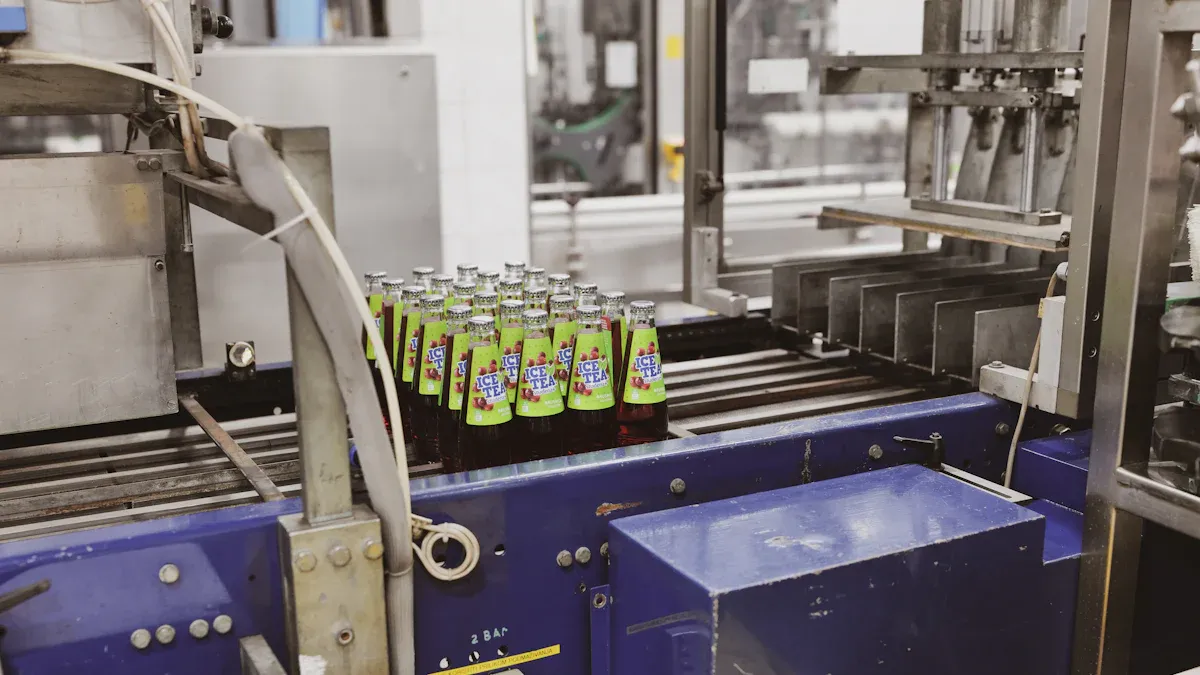
Researching Brand Reputation and Customer Reviews
Manufacturers often rely on brand reputation and customer feedback to gauge the long-term performance of a bottle making machine. Companies with strong reputations typically invest in precision engineering and advanced features. Regular maintenance and calibration play a vital role in maintaining accuracy and reliability. Cleaning, lubricating, and replacing worn parts prevent breakdowns and extend machine lifespan. Calibration ensures each unit meets exact specifications for size, weight, and wall thickness, which supports consistent bottle quality and regulatory compliance.
| Feature | Impact on Quality and Reliability |
|---|---|
| Precision Engineering | Ensures bottles have consistent dimensions, reducing defects and waste |
| Servo Stretch Blowing | Minimizes irregularities, enhancing bottle structural quality |
| Infrared Heating System | Maintains uniform wall thickness and prevents stress marks |
Automation and smart control systems enable real-time monitoring and predictive maintenance, which further enhance reliability and reduce downtime.
Checking Certifications and Industry Standards
Certifications and compliance with industry standards signal a manufacturer’s commitment to quality and safety. Leading companies pursue globally recognized certifications such as FSSC 22000, BRCGS, SQF, ISO 22000, HACCP, and GMP. These certifications ensure food safety, hygiene, and traceability. Regulatory bodies like the FDA and SFCR set additional requirements. Industry leaders such as Nestlé and Coca-Cola implement these standards across their operations. Key compliance pillars include food safety plans, accurate labeling, traceability, employee training, and sustainability.
- FSSC 22000 and ISO 22000 cover food safety management.
- BRCGS and SQF address high-risk environments.
- HACCP and GMP focus on hazard control and operational hygiene.
Assessing Energy Consumption and Sustainability
Energy efficiency and sustainability have become top priorities in bottle manufacturing. Modern machines use AI-driven systems to optimize heating and blowing profiles, reducing manual intervention and energy use. Automated mold changeovers and lighter bottle designs further lower energy consumption. Many manufacturers now invest in equipment compatible with recycled PET and biodegradable plastics.
Consumer demand for sustainable packaging drives these innovations. Upgrading to advanced machines can reduce energy use by up to 50%. BFC Monoblock Machines, for example, integrate multiple bottling functions, use smart sensors, and support recyclable materials, which significantly cut operational costs and environmental impact.
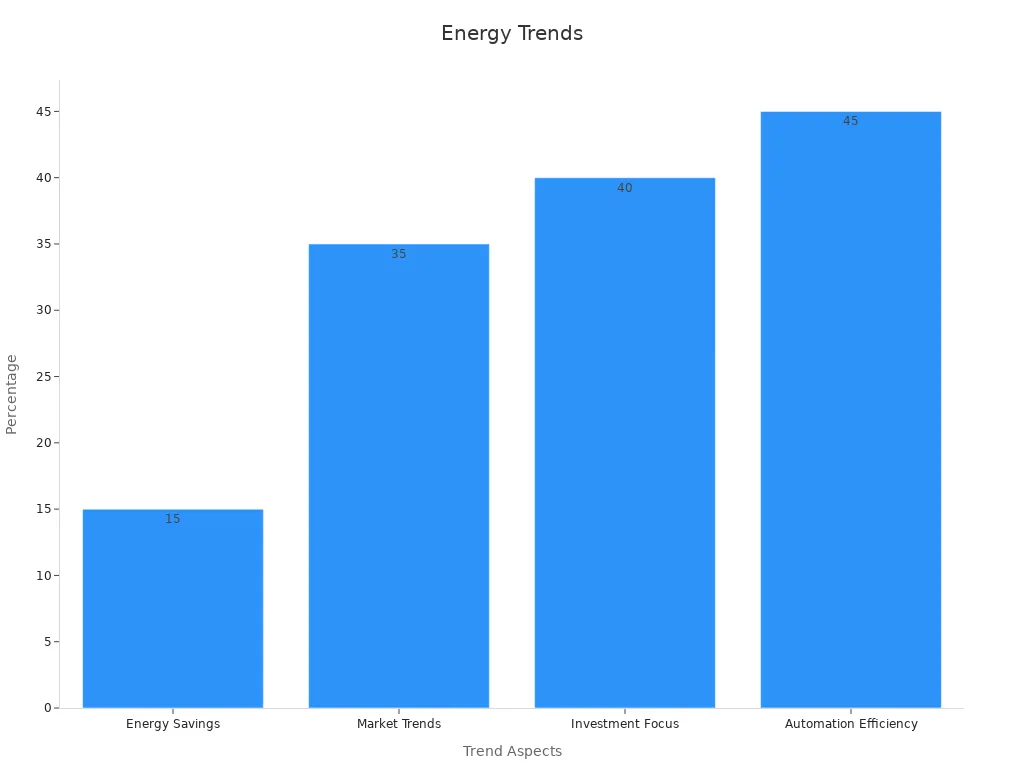
| Aspect | Details |
|---|---|
| Energy Consumption Impact | Energy accounts for ~20% of operational costs; traditional machines consume 25% more energy than hybrid models. |
| Energy Savings | Hybrid machines reduce power consumption by approximately 15%. |
| Market Trends | 35% increase in machines compatible with biodegradable plastics and recycled PET (rPET). |
| Investment Focus | Over 40% of new investments target energy reduction and recyclability improvements. |
Considering After-Sales Support and Service for Bottle Making Machines
Understanding Warranty and Service Agreements
A comprehensive warranty and clear service agreements provide peace of mind for manufacturers investing in a bottle making machine. Leading providers typically offer a one-year free warranty and lifetime after-sales service. Customers benefit from online troubleshooting support, on-site engineer dispatch for repairs, and free fragile parts as standard. Installation support often includes engineers who install the machine and train operators, with the first three days of installation free (excluding travel and accommodation). The following table summarizes key aspects of after-sales service:
| Aspect | Details |
|---|---|
| Warranty | One year free; lifetime after-sales service |
| Service Methods | Online support, engineer dispatch abroad |
| Installation Support | Onsite installation, operator training, free for first 3 days |
| Spare Parts | Fragile parts provided free |
| Service Team | 9 technicians available for overseas service |
Evaluating Technical Support and Response Times
Fast technical support and minimal downtime are essential for efficient operations. Providers emphasize quick response times and offer after-hours emergency support. Predictive maintenance programs help reduce unplanned downtime and enable future planning. Training programs and real-time tools, such as IQ tablets, optimize equipment effectiveness. Companies maintain technical support hotlines for North America and Europe, ensuring global reach and rapid assistance.
Ensuring Spare Parts Availability
Reliable spare parts availability keeps production running smoothly. Manufacturers use real-time data and AI-driven systems to maintain optimal inventory levels. Inventory replenishment occurs daily or weekly, based on demand forecasts and supplier lead times. Collaboration with suppliers improves responsiveness and reduces lead times. Accurate demand forecasting and integration with maintenance planning ensure spare parts align with scheduled maintenance. Service level models, such as fill rate models, help measure and maintain availability.
Setting a Realistic Budget for Your Bottle Making Machine
Balancing Cost with Value and Essential Features
A well-planned budget forms the foundation of a successful manufacturing operation. Companies should analyze both upfront and ongoing expenses before making a purchase. The following table outlines typical cost categories and their estimated ranges:
| Expense Category | Estimated Cost Range | Notes and Context |
|---|---|---|
| Equipment (Injection Molding) | $150,000 – $250,000 | High-quality machinery; leasing options can reduce upfront costs. |
| Startup Budgets by Scale | $25,000 (small) to $1M+ | Small operations may lease; large-scale setups invest in automation and sustainability. |
| Environmental Compliance | $20,000 – $50,000 | Covers waste management and pollution control. |
| Market Research | $10,000 – $30,000 | Supports feasibility and competitive analysis. |
| Business Plan Development | $5,000 – $15,000 | Professional consultation for funding and strategy. |
| Skilled Labor | Around $80,000 | Initial hiring for technicians and operators. |
| Quality Control Systems | Approximately $30,000 | Ensures compliance with standards. |
| Facility Setup | $500,000 – $1,000,000 | Includes rental, modifications, and compliance upgrades. |
| Energy-Efficient Machinery | $250,000 – $750,000 | Reduces energy use and supports sustainability. |
| Waste Management Systems | $50,000 – $150,000 | Manages by-products and environmental impact. |
| Recycling Program Development | $100,000 – $300,000 | Reduces raw material costs and enhances sustainability. |
Proper capital budgeting prevents negative cash flow and operational risks. For example, Steel String Brewery’s investment study showed that careful planning of equipment, labor, and related expenses helped avoid financial instability. Companies should also maintain a contingency fund of 10-15% of total costs to address unexpected expenses.
Tip: Leasing equipment, seeking bulk discounts, and exploring grants can help manage initial costs and improve long-term value.
Avoiding Unnecessary Add-Ons
Industry reports reveal that unnecessary add-ons can inflate the total investment without delivering proportional benefits. Companies often encounter the following pitfalls:
- Automation and advanced control systems that exceed actual production needs
- Specialized molds or multi-layer extrusion capabilities not required for current product lines
- Energy efficiency components that do not align with facility infrastructure
- Custom features that increase complexity and maintenance costs
These extras raise the initial purchase price and add to installation, maintenance, and operating expenses. Procurement teams should prioritize features that align with core production requirements. Balancing upfront costs with long-term return on investment ensures financial sustainability.
Note: Focus on essential features and avoid over-customization to keep budgets realistic and operations efficient.
Planning for Future Scalability with Bottle Making Machines
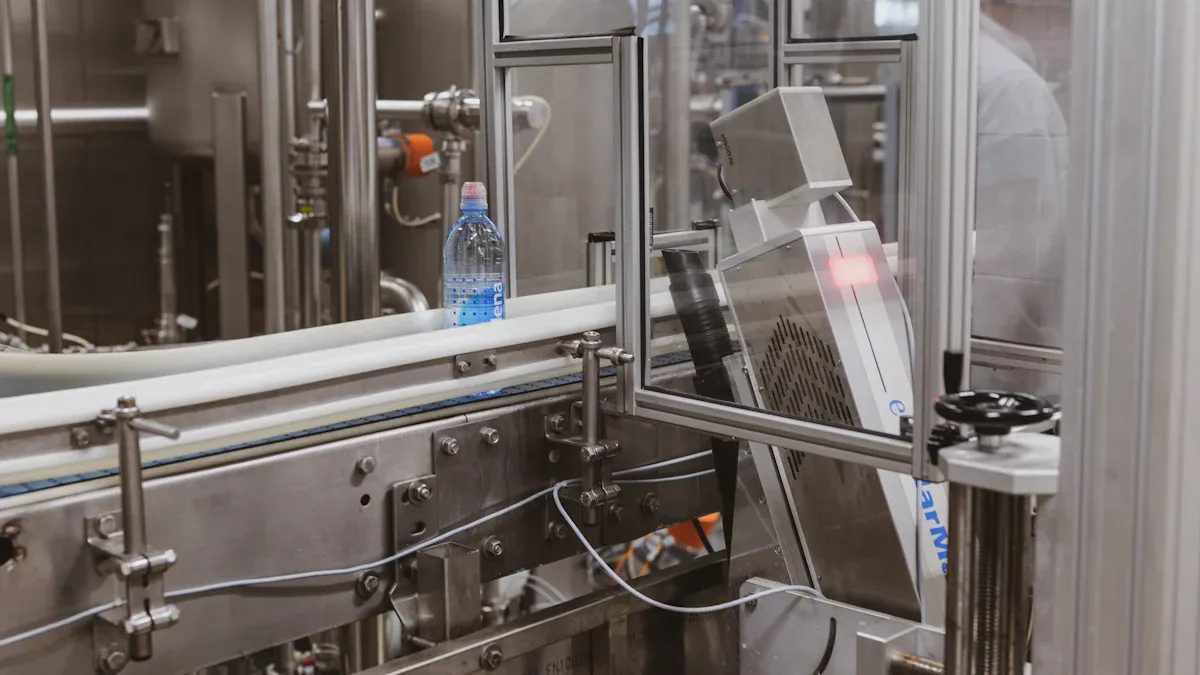
Exploring Modular and Upgradeable Machine Options
Manufacturers seeking long-term success often choose modular and upgradeable systems. Modular filling systems allow companies to add new units as demand increases, boosting speed without disrupting the entire line. This design also enables maintenance on specific sections, which minimizes production interruptions. Real-time monitoring and analytics support predictive maintenance, reducing downtime by addressing issues before failures occur. Batch tracking and statistical process control help maintain accuracy by continuously adjusting filling parameters.
Key technical improvements include:
- Easy integration of advanced technologies, such as automated sensors, which improve accuracy and reduce errors.
- Adaptability to different packaging types and sizes, supporting quick responses to market changes.
- Maintenance and upgrades performed on individual modules, lowering complexity and costs.
- Seamless integration with existing systems, which enhances operational efficiency.
Although modular systems may require higher initial investment, their return on investment improves through reduced downtime, lower maintenance expenses, and increased production capacity.
Preparing for Business Growth and Expansion
The bottle manufacturing industry is poised for significant growth. Market forecasts estimate the global market will reach approximately USD 78.2 billion by 2035, with a compound annual growth rate of 5.7%. The following table highlights key growth drivers and opportunities:
| Aspect | Details |
|---|---|
| Market Size (2025) | Approx. USD 44.9 billion |
| Market Size (2035) | Approx. USD 78.2 billion |
| CAGR (2025-2035) | 5.7% |
| Growth Drivers | Eco-friendly packaging, regulations, smart packaging, RFID, lightweight glass |
| Opportunities | IoT-enabled packaging, AI-driven defect detection, premium eco-friendly innovations |
Manufacturers can support expansion by upgrading equipment with automated filling, packaging, and labeling systems. Outsourcing to contract manufacturers adds capacity when facility upgrades are not feasible. Strong supply chain relationships ensure stability as demand grows. The chart below illustrates the impact of strategic planning on business growth metrics:
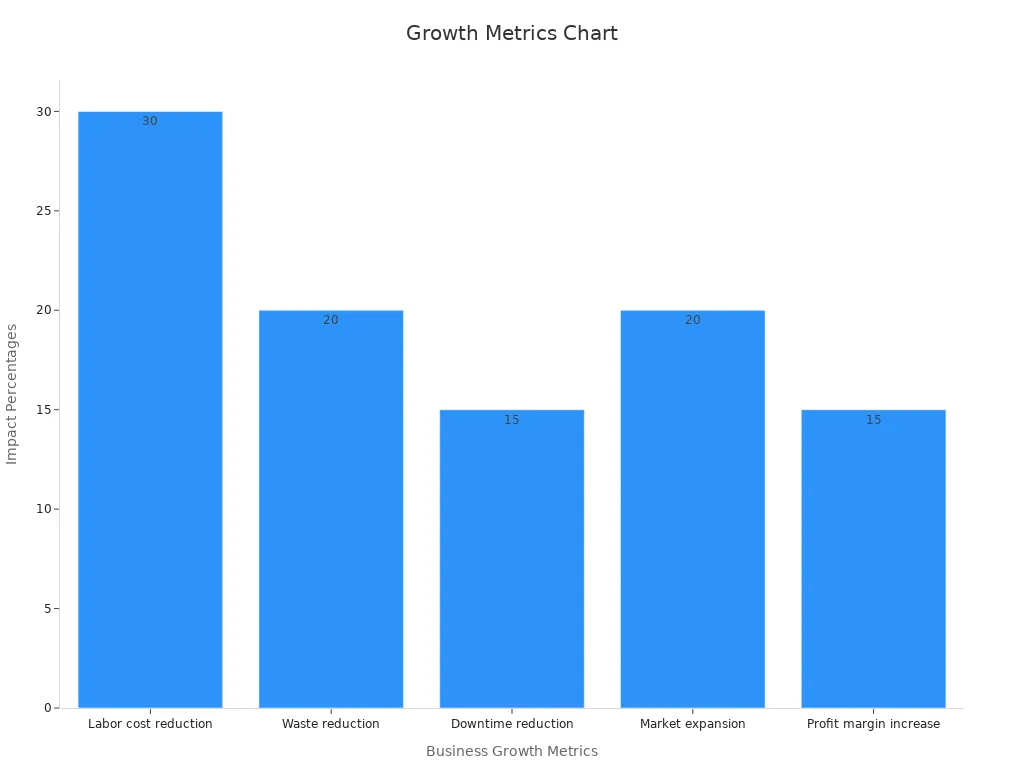
Tip: Routine maintenance and lean manufacturing can reduce downtime by 15% and waste by up to 20%, directly supporting scalable growth.
Selecting the right equipment supports both current production and future growth. Companies see long-term benefits, as shown below:
| Aspect | Summary |
|---|---|
| Market Growth | Projected value of USD 6.31 billion by 2032; CAGR of 3.4% |
| Industry Drivers | Food, beverage, chemical, and cosmetic sectors drive adoption |
| Technology Advances | Machines now handle multiple substrates and capping needs |
Consulting reputable suppliers helps businesses align investments with production goals and market trends.
FAQ
What factors determine the lifespan of a bottle making machine?
Routine maintenance, quality of components, and operating conditions influence machine lifespan. Most machines last 10–15 years with proper care.
How often should operators perform maintenance on bottle making machines?
Operators should follow the manufacturer’s recommended schedule. Most machines require daily checks, monthly inspections, and annual servicing for optimal performance.
Can a bottle making machine handle multiple bottle designs?
Many modern machines support quick mold changes and flexible programming. This allows manufacturers to produce various bottle shapes and sizes efficiently.
Post time: Jun-19-2025



